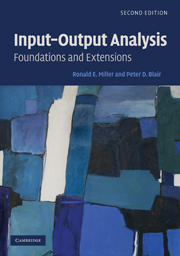Book contents
- Frontmatter
- Contents
- List of Figures
- List of Tables
- Preface
- 1 Introduction and Overview
- 2 Foundations of Input–Output Analysis
- 3 Input–Output Models at the Regional Level
- 4 Organization of Basic Data for Input–Output Models
- 5 The Commodity-by-Industry Approach in Input–Output Models
- 6 Multipliers in the Input–Output Model
- 7 Nonsurvey and Partial-Survey Methods: Fundamentals
- 8 Nonsurvey and Partial-Survey Methods: Extensions
- 9 Energy Input–Output Analysis
- 10 Environmental Input–Output Analysis
- 11 Social Accounting Matrices
- 12 Supply-Side Models, Linkages, and Important Coefficients
- 13 Structural Decomposition, Mixed and Dynamic Models
- 14 Additional Topics
- Appendix A Matrix Algebra for Input–Output Models
- Appendix B Reference Input–Output Tables for the United States (1919–2006)
- Appendix C Historical Notes on the Development of Leontief's Input–Output Analysis
- Author Index
- Subject Index
3 - Input–Output Models at the Regional Level
Published online by Cambridge University Press: 05 June 2012
- Frontmatter
- Contents
- List of Figures
- List of Tables
- Preface
- 1 Introduction and Overview
- 2 Foundations of Input–Output Analysis
- 3 Input–Output Models at the Regional Level
- 4 Organization of Basic Data for Input–Output Models
- 5 The Commodity-by-Industry Approach in Input–Output Models
- 6 Multipliers in the Input–Output Model
- 7 Nonsurvey and Partial-Survey Methods: Fundamentals
- 8 Nonsurvey and Partial-Survey Methods: Extensions
- 9 Energy Input–Output Analysis
- 10 Environmental Input–Output Analysis
- 11 Social Accounting Matrices
- 12 Supply-Side Models, Linkages, and Important Coefficients
- 13 Structural Decomposition, Mixed and Dynamic Models
- 14 Additional Topics
- Appendix A Matrix Algebra for Input–Output Models
- Appendix B Reference Input–Output Tables for the United States (1919–2006)
- Appendix C Historical Notes on the Development of Leontief's Input–Output Analysis
- Author Index
- Subject Index
Summary
Introduction
Originally, applications of the input–output model were carried out at national levels – for example, to assess the impact on the individual sectors of the US economy of a change from war to peacetime production as the end of World War II approached. Over time, interest in economic analysis at the regional level – whether for a group of states (as in a federal reserve district), an individual state, a county or a metropolitan area – has led to modifications of the input–output model which attempt to reflect the peculiarities of a regional (subnational) problem. There are at least two basic features of a regional economy that influence the characteristics of a regional input–output study.
First, although the data in a national input–output coefficients table are obviously some kind of averages of data from individual producers located in specific regions, the structure of production in a particular region may be identical to or it may differ markedly from that recorded in the national input–output table. Soft drinks of a particular brand that are bottled in Boston probably incorporate basically the same ingredients in the same proportions as are present in that brand of soft drink produced in Kansas City or Atlanta or in any other bottling plant in the United States. On the other hand, electricity produced in eastern Washington by water power (Coulee Dam) represents quite a different mix of inputs from electricity that is produced from coal in Pennsylvania or by means of nuclear power or “wind farms” elsewhere.
- Type
- Chapter
- Information
- Input-Output AnalysisFoundations and Extensions, pp. 69 - 118Publisher: Cambridge University PressPrint publication year: 2009
- 1
- Cited by



